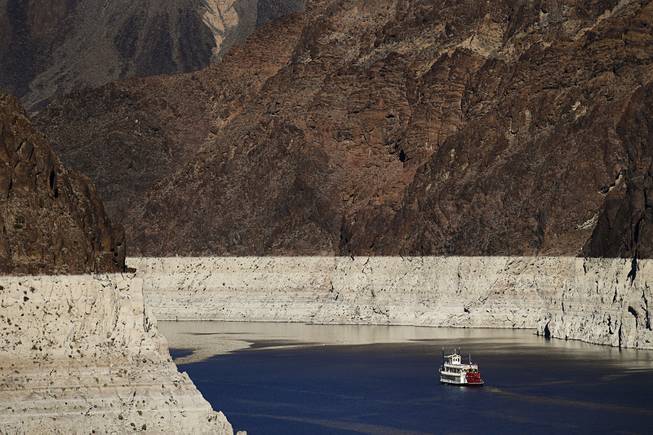
Jae C. Hong / AP
In this Wednesday, Oct. 14, 2015, photo, a riverboat glides through Lake Mead on the Colorado River at Hoover Dam near Boulder City. The bathtub ring shows how far the water level has dropped in recent years.
Thursday, May 19, 2016 | 2 a.m.
Lake Mead’s surface Wednesday evening hit its lowest level since the man-made reservoir was created by the building of the Hoover Dam in 1935.
The surface of the lake — a critical source of water for Nevada, California, Arizona and Mexico — is expected to drop lower in the coming weeks, but rebound before the beginning of next year, when jurisdictions would be asked to accept shortages in supply.
At 7 p.m. Wednesday, the elevation inched below the past record set last June, when it hit 1,074.70 feet, according to hourly data from the U.S. Bureau of Reclamation, the federal agency responsible for overseeing Western water management and the Hoover Dam.
“This is the early warning signal,” said Drew Beckwith, a water policy manager with Western Resource Advocates, a conservation group. He said that it signifies that more water is being used than the Colorado River, which feeds Lake Mead, provides.
“It’s about an over-allocated resource,” he said.
Projections show the lake could continue dropping about 3 more feet through June, ebbing farther from a full capacity of 1,221 feet above sea level, which was last achieved in 1983. Facing a drought of more than a decade, it has dropped 130 feet since 2000.
“It’s a visual and physical manifestation for all of us,” said Rose Davis, a spokesperson for the Bureau of Reclamation. She added that water issues are plaguing countries throughout the world and that Lake Mead provides an illustration. “We might not see it globally but we can certainly see the bathtub ring.”
For now, the drop is largely symbolic since shortages are not likely to be triggered next year. But states could face cuts in 2018. No resource planning is an exact science, but the Bureau of Reclamation says there is a higher chance states will be asked to voluntarily reduce their Lake Mead allocations in 2018.
States connected to the lower Colorado River basin — Nevada, California and Arizona — are in the process of negotiating a deal that would require them to accept further reductions. The talks are part of an effort to maintain Lake Mead as a water resource.
The river is fed by snow melt in the Rocky Mountains.
Nevada’s water allotment of 300,000 acre-feet from the lake provides most of the valley’s drinking water (for reference, one acre-foot can meet the demand of two Las Vegas homes for a year). But the Southern Nevada Water Authority told the Sun earlier this month that it was building a water system impervious to elevation drops.
“We are building a water delivery system that will ensure a secure water supply regardless of lake levels in Lake Mead,” John Entsminger, SNWA’s general manager, said last week.
Last fall, the water authority completed a “third straw” project that would draw water from the bottom of the lake if surface elevations were to drop below a critical level of 1,000 feet. SNWA can call on more than 1 million acre-feet of water in the case of a shortage.
Beyond the drought and climate change, Beckwith said that what is also driving the drop is that Lake Mead loses more water than it takes in. He said states have come to recognize this in recent years.
Davis, with the Bureau of Reclamation, said that as states negotiate more voluntary reductions, individuals should also play a role in conservation and improving their water usage practices.
“(The water agencies are) doing what we can,” she said. “But it’s got to go farther than that. It’s got to go down to the individual.”
Many states, including Nevada, have made strides in conservation that focuses on the end-user, but Beckwith said more can be done.
“In the cities, we’re going to need to start deploying next-generation urban water efficiency measures,” he said. “How do you affect personal behavior rather than how do you just affect the toilets and the showers and the appliances that use water?”

Join the Discussion:
Check this out for a full explanation of our conversion to the LiveFyre commenting system and instructions on how to sign up for an account.
Full comments policy